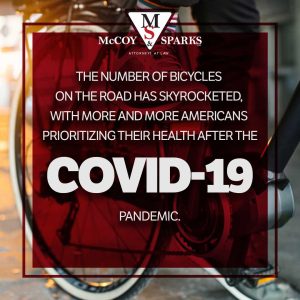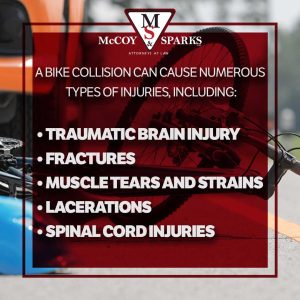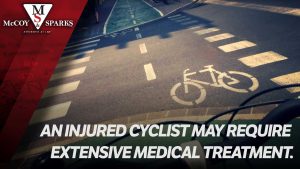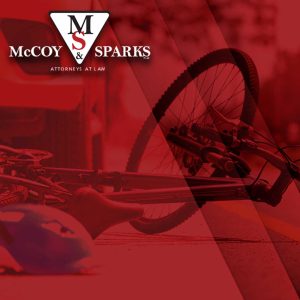
In recent years, the number of bicycles on the road has skyrocketed, with more and more Americans prioritizing their health after the COVID-19 pandemic.
While riding a bicycle offers great advantages over driving, they do not provide riders with bodily protection. Cyclists are highly susceptible to serious injuries in bike accidents. The risk of injury is especially high if you’re struck by a car or other motor vehicle. Tragically, it’s common for cyclists to suffer severe injuries in Kentucky, and many have even sustained fatal injuries.
If you’ve suffered from a bike accident caused by someone else’s negligence, you must contact a bicycle lawyer familiar with bike law.
A bicycle accident attorney specializing in car and bicycle accident cases can help you recover damages for your accident. Call McCoy and Sparks Law Firm today at 844-459-9467.
McCoy & Sparks: Helping Injured Cyclists

The bicycle accident lawyers at McCoy & Sparks have years of experience serving the best interests of injured victims across Kentucky. Our bike law firm fights on behalf of riders to secure the money they deserve from careless drivers and other negligent parties.
When you work with a bike accident lawyer on our team, you can rest assured that you’ll receive the most money possible for your injuries. You also won’t need to worry about paying our attorneys. Our bicycle accident attorneys receive compensation from contingency fees, meaning you won’t need to pay us a cent until we win or settle your case.
Our office is located in Bardstown, and we’re especially active in Central Kentucky.
In addition to assisting injured bicyclists, we specialize in car accidents, pedestrian accidents, workers’ compensation, medical malpractice, and more.
How Can A McCoy & Sparks Bicycle Accident Attorney Help?

Bike accident victims are far more likely to experience debilitating injuries than standard vehicle drivers. Unlike a car, a bicycle doesn’t provide its rider with external protection or safety devices, such as airbags. When a cyclist collides with a motor vehicle or object, they have a high likelihood of suffering from a personal injury.
An injured cyclist may require extensive medical treatment, and they may also struggle to work while in recovery. Further, a bike accident victim may experience post-traumatic stress disorder and permanent physical disabilities.
If you were injured due to someone else’s negligence, you shouldn’t have to pay out of pocket for your damages. Fortunately, each accident lawyer at McCoy & Sparks can fight on your behalf to maximize your compensation.
The bike crash attorneys at McCoy & Sparks help their clients by:
- Collecting important evidence to build your claim
- Explaining bike law and your legal options
- Unpacking what compensation you can expect to recover according to the law
- Communicating with the person who caused your bike collision and their insurance company
- Ensuring you file your claim correctly with the insurance companies
- Negotiating your settlement
- Representing you in court if we can’t reach a favorable settlement
What Injuries Do Victims Sustain in Bike Accidents?
A bike collision can cause numerous types of injuries, some of which may be fatal or cause permanent disabilities.
An injured cyclist may suffer from:

- Traumatic brain injuries
- Multiple fractures
- Muscle tears and strains
- Nerve damage
- Lacerations
- Contusions
- Spinal cord injuries
- Renal contusions
- Vascular perforations
- Internal injuries
- Lung injuries
- Crush injuries
- Road rash

If you suffer from bicycle accident injuries, you must receive medical attention as soon as possible. Getting medical care promptly will be important to your attorney for proving your claim, and your injuries may require immediate treatment.
Who May Be At Fault for My Bicycle Accident?

Bike accidents can occur for many reasons. Sometimes, these collisions happen due to negligent drivers, but bicyclists can also be at fault. The party at fault usually depends on who broke traffic laws at the time of the accident and who had the right of way.
Sometimes, cyclists are at fault rather than drivers. Picture a bicyclist who recently started riding and isn’t aware of Kentucky bike laws. They regularly ride their bicycle through red lights, believing that cars need to yield to them because they’re on a bike. If a car strikes the rider at an intersection, the cyclist will likely be liable and have to pay for the accident.
There are also instances when two or more people involved in an accident can share liability under the law.
Additionally, an unseen third party could be responsible for an accident. Suppose you crash your bike because of a hazardous pothole in the bike lane. A state or municipal agency could be responsible for your damages if they were in charge of the road’s upkeep.
A bicycle accident attorney can help you identify all parties who may be liable for your crash.
Common Causes of Bicycle Accidents
The person, company, or agency liable for your damages will depend on the circumstances surrounding your accident.
Some common reasons why bike accidents occur include:
- A driver opens their car door suddenly
- A driver rear ends or sideswipes a rider
- A cyclist’s bike has faulty equipment
- A cyclist crashes due to hazardous road irregularities or obstacles
- A driver hits a rider when turning
- A driver fails to see a rider who has the right of way at an intersection
- Bicyclists collide with one another
- A cyclist crashes to avoid hitting a jaywalker
Bicycle Safety Tips
While bicycle accidents are sometimes unavoidable, you can take necessary safety measures to reduce your chances of suffering a significant crash.
Take the following precautions:
- Always wear a helmet
- Follow each Kentucky bike law
- Yield to motorists and bicyclists with the right of way
- Don’t ride on the sidewalk
- Never ride while under the influence of alcohol or drugs
- Use hand signals when turning
- Never make sudden turns
- Wear reflective clothing
- Maintain a safe speed
- Slow down when turning
- Plan your route to minimize riding in heavy traffic
- Avoid baggy clothing, dangling shoelaces, or anything else that could get caught in your bike wheels
What Should I Do After a Bicycle Crash?
If you suffer from a bike collision, you need to take action to protect yourself. It’s also important to gather evidence at the scene.
Ensure you do the following after your bike crash:

- Receive emergency medical care at the scene by calling 911 if necessary.
- Call the police and wait for them to arrive. They’ll create a police report that you can use to strengthen your claim.
- Exchange insurance, contact information, and police report number if a driver or another bicyclist was involved.
- Take many photos and videos of your bike and other vehicles that were involved. You should also photograph any factors that may have contributed to your accident, such as road conditions.
- Speak with anyone who saw the accident occur. Write down their accounts, names, and contact information to give to your attorney.
- Go to a doctor if you haven’t already received medical care at the scene.
- Preserve additional evidence of your crash, including your clothes, biking gear, and your bicycle.
- Contact a bike law attorney who specializes in representing injured cyclists.
- Don’t speak with the at-fault party’s insurance company directly. Have your attorney handle all communication.
- Don’t post about your accident on social media, as this can hurt your claim.
Recover Damages for Your Bicycle Accident

The compensation you can recover for your bicycle accident is meant to compensate you for the real value of your damages, including economic and non-economic damages.
Economic damages are meant to cover specific monetary amounts based on your financial losses. These damages can include money for medical bills, lost wages, property damage, and loss of future earnings.
Non-economic damages compensate you for intangible losses. These losses don’t have a set monetary value. For instance, you can recover compensation for the physical and emotional pain and suffering you experienced due to your accident.
Can Bicycle Crash Victims File Suit Against Insurance Companies?
If you can’t reach a settlement with the at-fault party’s insurance company, you can file a lawsuit with your attorney. In the event you need to sue an insurance company, it’s critical that you seek the legal assistance of trial lawyers.
Law firms specializing in bicycle accidents have experience in dealing with insurance companies. If negotiations break down and your attorney can’t recoup fair compensation, they’ll represent you in court. Fortunately, the vast majority of bike accident cases settle.

Meet with a Kentucky Bicycle Accident Attorney at McCoy & Sparks
The process of recovering fair compensation after a bike accident can be tough, but you don’t need to go through it alone. Here at McCoy & Sparks Attorneys at Law, our independent bicycle accident attorneys have many years of experience assisting bicycle accident clients and will ensure you get the most money possible for your crash in accordance with bike law.
Depending on the circumstances surrounding your case, you and your attorney may be able to recover compensation for medical expenses, lost wages, pain and suffering, and other damages.

